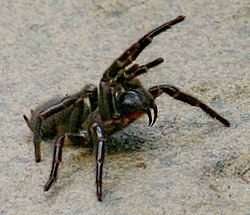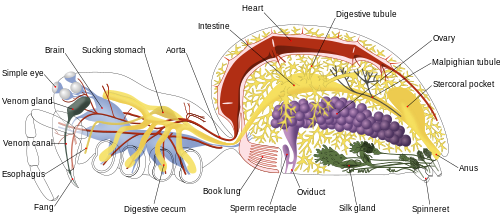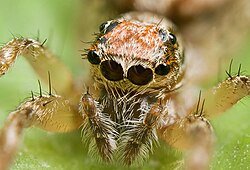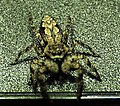Spider
Spiders (class Arachnida, order Araneae) are air-breathing arthropods. They have eight legs, and mouthparts (chelicerae) with fangs that inject venom. Most make silk. The arachnids are seventh in number of species of all animal orders.[2] About 48,000 spider species, and 120 families have been recorded by taxonomists.[3] Over twenty different classifications have been proposed since 1900.[4]p3 Spiders live on every continent except for Antarctica, and in nearly every habitat with the exceptions of air and sea.
| Spiders Temporal range: Pennsylvanian – Holocene, 319 mya to present
| |
|---|---|

| |
| An assortment of different spiders. | |
| Scientific classification | |
| Kingdom: | Animalia |
| Phylum: | Arthropoda |
| Class: | Arachnida |
| Order: | Araneae Carl Alexander Clerck 1757 |
| Suborders | |
| Diversity[1] | |
| 113 families, c. 46,000 species | |
Almost all spiders are predators, and most eat insects. They catch their prey in several ways. Some build a spider web, and some use a thread of silk that they throw at the insect. Some kinds of spiders hide in holes in the ground, then run out and grab an insect that walks by. Others will make web 'nets' to throw at passing insects. Or they go out and simply attack their prey. Some can jump quite well and hunt by sneaking close to an insect and then jumping on it.
Anatomy
Spiders have a two-part body, the front part (cephalothorax) and the abdomen. Unlike insects, spiders do not have antennae. The more advanced spiders have a centralized nervous system, with their ganglia fused into one mass in the cephalothorax. Unlike most arthropods, spiders have no extensor muscles in their limbs, and extend them by hydraulic pressure.
Size range
The smallest of full-grown spiders can be less than 4 mm. (0.1 inch). The largest of spiders can have a body length of 10 cm. (4 inches) or more. The largest can weigh 150 grams (5.3 oz). The largest of spiders are the tarantulas and the huntsman spiders. Some huntsman spiders in South East Asia can have a leg span of around 250–300 mm (9.8–11.8 in).
Spider eyes and other senses
Most spiders have four pairs of eyes on the top-front area of the body, arranged in patterns that vary from one family to another. The main eyes at the front are capable of forming images.[5] Jumping spiders have visual acuity which is ten times better than that of dragonflies, which have by far the best vision among insects. The spiders do this by a telephoto-like series of lenses, a four-layered retina. They can swivel their eyes and put together images from different stages in the scan. The downside is that the scanning and integrating processes are relatively slow.[6]
Spiders and other arthropods have modified their cuticles into elaborate arrays of sensors. Various sensors, mostly bristles, respond to touch, from strong contact to very weak air currents. Chemical sensors provide equivalents of taste and smell.[5] Spiders also have in the joints of their limbs sensors that detect forces and vibrations. In web-building spiders all these mechanical and chemical sensors are more important than the eyes. The eyes are more important to spiders that hunt actively. Like most arthropods, spiders lack balance sensors, and rely on their eyes to tell them which way is up.[5]
Fangs
Even a relatively large spider can have fangs with very sharp points. The fangs are hollow, like the needles used to give shots. Spiders use their fangs to inject toxins that kill the insects they will eat. Some kinds of spider venom attack the nervous systems of their prey, and other kinds of venom attack body tissues.
Behavior
What most spiders eat
Almost all spiders are predators, and eat insects and other arthropods (including other spiders). Most use venom from their fangs to kill their prey. It is rare for spiders to capture prey that are much larger than they are. It is also difficult for most spiders to capture prey that are very much smaller than they are. Most species of spiders cannot live close together because they treat each other as their next meal, but there are some spiders that form colonies. Spiders eat not only spiders of other species, but spiders of their own species.
The black widow spider got its name because the females sometimes eat the males that mate with them. This may also happen in other species. Each species of spider has its own way of communicating with other spiders they meet. Because of the danger of being eaten, in some species the males have special hooks on their front legs with which they hold the female while they mate. Others bring the female something to eat. There are a few species in which the male spiders construct their own little webs that are connected to the webs of the females. In these species, the male is so much smaller than the female that it would be difficult for her to actually capture the male.
Most spiders have such poor vision that they will not even notice a dead insect. Jumping spiders are one exception to this rule. They have such good vision that they can find recently dead flies or other insects to eat.
Some spiders are not predators
Most spiders are predators, but the jumping spider Bagheera kiplingi gets over 90% of its food from fairly solid plant material produced by acacias as part of a beneficial relationship with a species of ant.[7]
Young spiders of several families feed on plant nectar. Studies have shown that they do this for long periods. They also clean themselves regularly while feeding. These spiders also prefer sugar solutions to plain water, which shows that they are looking for nutrients. Many spiders are nocturnal, they are most active during the night. The extent of nectar consumption by spiders may therefore have been under-estimated. Nectar contains amino acids, lipids, vitamins and minerals in addition to sugars. Studies have shown that other spider species live longer when nectar is available. Feeding on nectar also avoids the risks of struggles with prey, and the costs of producing venom and digestive enzymes.[8]
Various species are known to feed on dead arthropods (scavenging), web silk, and their own shed exoskeletons. Pollen caught in webs may also be eaten, and studies have shown that young spiders have a better chance of survival if they have the opportunity to eat pollen. In captivity, several spider species are also known to feed on bananas, marmalade, milk, egg yolk and sausages.[8]
Methods of catching prey
Webs
The best-known method spiders use to capture prey is a sticky web. The placing of the web allows different spiders to trap different insects in the same area. Flat, horizontal webs allow them to trap insects that fly up from vegetation underneath, for example. Flat vertical nets allow them to trap insects in flight. The spiders that build webs usually do not see very well, but they are very sensitive to vibrations.[5]
Underwater
Females of the water spider Argyroneta aquatica build underwater "diving bell" webs which they fill with air and use eating their prey, molting, mating, and raising offspring. They live almost entirely within the bells, darting out to catch prey animals that touch the bell or the threads that anchor it.[9] A few spiders use the surfaces of lakes and ponds as "webs", detecting trapped insects by the vibrations that these cause while struggling.[5]
Bola casting
Net-casting spiders weave only small webs but then manipulate them to trap prey. They stretch their webs and then release them when prey strike them. Those of the family Deinopidae weave even smaller webs, hold them outstretched between their first two pairs of legs, and lunge and push the webs as much as twice their own body length to trap prey, and this move may increase the webs' area by a factor of up to ten. Experiments have shown that Deinopis spinosus has two different techniques for trapping prey: backwards strikes to catch flying insects, whose vibrations it detects; and forward strikes to catch ground-walking prey that it sees. These two techniques have also been observed in other deinopids. Walking insects form most of the prey of most deinopids, but one population of Deinopis subrufus appears to live mainly on tipulid flies that they catch with the backwards strike.[10]
Mature female bolas spiders of the genus Mastophora build "webs" that consist of only a single "trapeze line", which they patrol. They also construct a bolas made of a single thread, tipped with a large ball of very wet sticky silk. They emit chemicals that resemble the pheromones of moths, and then swing the bolas at the moths. They catch about the same weight of insects per night as web-weaving spiders of similar size. The spiders eat the bolas if they have not made a kill in about 30 minutes, rest for a while, and then make new bolas.[11][12] Juveniles and adult males are much smaller and do not make bolas. Instead they release different pheromones that attract moth flies, and catch them with their front pairs of legs.[13]
Using trapdoors

The primitive Liphistiidae, the "trapdoor spiders" (family Ctenizidae) and many tarantulas are ambush predators. They lurk in burrows, often closed by trapdoors and surrounded by networks of silk threads that alert these spiders to the presence of prey.[14] Other ambush predators do without such aids, including many crab spiders.[5] A few species that prey on bees, which see ultraviolet, can adjust their ultraviolet reflectance to match the flowers in which they are lurking.[15] Wolf spiders, jumping spiders, fishing spiders and some crab spiders capture prey by chasing it, and rely mainly on vision to get their prey.[5]
Capturing insects without using webs
Not all spiders use silk to net their prey. Instead, these spiders may capture insects by grabbing them and then biting them. Among these kinds of spiders the two best known are the wolf spiders and the jumping spiders.
Wolf spiders
A wolf spider will usually wait until an insect comes near to it, and then rush at the insect, grab it using its front legs, and then bite the insect so that its venom can do its work.
Female wolf spiders lay their eggs on a pad of silk and then draw the edges together to create a round ball that they carry along with them wherever they go. They hold their egg balls to their tail ends by using their silk. When the eggs hatch, the little spiders will crawl onto the mother's back, and she will carry them along with her for days or weeks.
Wolf spiders are very good mothers and will strongly protect both their egg balls and their infants. When the time comes, the little spiders will leave the mother and each will go its own way.
Jumping spiders
Jumping spiders have very good eyes and can see well. They sneak as close to an insect as they can, and then they jump onto the insect and immediately bite it. Since they often hunt in trees, bushes, and on the sides of walls, if the jumping spider misses it may fall off. But they have a way to save themselves from harm. Before they jump they fasten their silk to the place where they have been standing, and as they jump they let out a silk safety line. So if they fall they will catch themselves when they reach the end of their silk safety line. Sometimes a jumping spider will catch an insect and then fall while still holding onto the insect. But the spider is still safe.
Jumping spiders make little silken "tents" for themselves to sleep in. When they lay eggs they keep them inside such a shelter. They do not take their eggs with them when they go out to hunt.
For all male spiders it is dangerous to seek a mate. The female spider may not realize that the male is a spider of her kind, so she may try to eat it. The jumping spiders not only have visual patterns that identify them to each other, but the male jumping spider will do a special dance when it approaches a female of the same species. That way, the female can recognize that it is a male of her species. She will generally forget about eating for long enough to mate with the visiting male spider.
Jumping spiders have such good eyes that they will usually watch any human who tries to watch them. Some species are very shy and will run away if the human gets too close. But some species, such as Phidippus audax (the audacious or brave jumping spider) and Platycryptus undatus, can become calm if the human comes close to them slowly. Sometimes they will jump onto one of your fingers and then jump from finger to finger and from hand to hand. They seem to want to explore.

Hunting other spiders
Some jumping spiders of the genus Portia hunt other spiders in ways that seem intelligent,[6] outflanking their victims or luring them from their webs. Laboratory studies show that Portia's instinctive tactics are only starting points for a trial-and-error approach from which these spiders learn very quickly how to overcome new prey species.[16] However, they seem to be relatively slow thinkers, which is not surprising as their brains are vastly smaller than those of mammalian predators.[6]
Disguising as ants

Ant-mimicking spiders face several challenges: they generally develop slimmer abdomens and false "waists" to mimic the three distinct regions (tagmata) of an ant's body; they wave the first pair of legs in form to their heads to mimic antennae, which spiders lack, and to conceal the fact that they have eight legs rather than six. They have large color patches round one pair of eyes to disguise the fact that they generally have eight simple eyes, while ants have two compound eyes; they cover their bodies with reflective hairs to resemble the shiny bodies of ants. In some spider species males and females mimic different ant species, as female spiders are usually much larger than males.
Ant-mimicking spiders also modify their behavior to resemble that of the target species of ant, for example many adopt a zig-zag pattern of movement, ant-mimicking jumping spiders avoid jumping, and spiders of the genus Synemosyna walk on the outer edges of leaves in the same way as Pseudomyrmex. Ant-mimicry in many spiders and other arthropods may be for protection from predators that hunt by sight, including birds, lizards and spiders. However several ant-mimicking spiders prey either on ants or on the ants "livestock" such as aphids. When at rest the ant-mimicking crab spider Amyciaea does not closely resemble Oecophylla, but while hunting it imitates the behavior of a dying ant to attract worker ants. After a kill some ant-mimicking spiders hold their victims between themselves and large groups of ants to avoid being attacked.[17]
Reproduction and life cycle



Spiders generally use elaborate courtship rituals to prevent the large females from eating the small males before fertilization, except where the male is so much smaller that he is not worth eating. In some species males mate with newly molted females, which are too weak to be dangerous to the males.[4]
In web-weaving species precise patterns of vibrations in the web are a major part of the rituals, while patterns of touches on the female's body are important in many spiders that hunt actively, and may 'hypnotize' the female. Gestures and dances by the male are important for jumping spiders, which have excellent eyesight.
Males do get eaten in some species. Males of the genus Tidarren cut off one of their palps, and enter adult life with one palp only. The palps are 20% of male's body mass in this species, and detaching one of the two improves mobility. In the Yemeni species Tidarren argo, the remaining palp is then torn off by the female. The separated palp remains attached to the female's opening for about four hours. In the meantime, the female feeds on the palpless male.[18] In over 60% of cases the female of the Australian redback spider kills and eats the male after it inserts its second palp into the female's genital opening; in fact the males co-operate by trying to impale themselves on the females' fangs. Observation shows that most male redbacks never get an opportunity to mate, and the 'lucky' ones increase the likely number of offspring by ensuring that the females are well-fed.[19] However males of most species survive a few matings, limited mainly by their short life spans. Some even live for a while in their mates' webs.[4]p176/212
Females lay up to 3,000 eggs in one or more silk egg sacs,[5] which maintain a fairly constant humidity level.[4] In some species the females die afterwards, but females of other species protect the sacs by attaching them to their webs, hiding them in nests, carrying them in the chelicerae or attaching them to the spinnerets and dragging them along.[5]
Development of young
Baby spiders pass all their larval stages inside the egg and hatch as spiderlings, very small and sexually immature but similar in shape to adults. Some spiders care for their young, for example a wolf spider's brood cling to rough bristles on the mother's back,[5] and females of some species respond to the "begging" behaviour of their young by giving them their prey, provided it is no longer struggling, or even regurgitate food.[4]
Like other arthropods, spiders have to moult to grow as their cuticle ("skin") cannot stretch.[5] Most spiders live for only one to two years, although some tarantulas can live in captivity for over 20 years.p232[4][5]
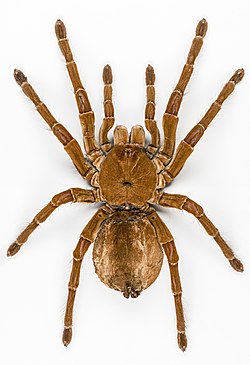
Spiders and humans
Of the 40,000 spiders, less than 12 are known to be dangerous to humans. Most of the time, being bitten by a spider is painful. Most spiders use venom to paralyse their prey; they kill it through eating, or through a bite. A few spiders have venoms that can be dangerous to weakened people and those allergic to it. Since 1927, 13 people have died, after a bite from a Atrax robustus spider from Australia.[20]
The spider that kills the most people, the black widow and other spiders in the genius Latrodectus are around 1 cm. in body length. The Atrax and Phoneutria spiders, which are also capable of killing people, both average around 2.5 cm. or one inch, and even the Widow spiders are large enough to be easily noticed.
Even relatively small spiders like Phidippus audax can give a painful bite if you hurt them, but spiders are very helpful to human beings because they control insects that eat our crops.
Being afraid of spiders is a very common phobia (fear). The widow spiders (black widows and other members of their genus) never willingly leave their webs, so usually people get bitten when they touch the spider by mistake.
Gallery
Click on a picture to see it larger:
Phoneutria nigriventer
Brazilian wandering spider
References
- ↑ "Currently valid spider genera and species". World Spider Catalog. Natural History Museum Bern. Retrieved 2016-12-19.
- ↑ Sebastin PA & KV Peter (ed) 2009. Spiders of India. Universities Press. ISBN 978-81-7371-641-6
- ↑ Platnick, Norman I. (2009). "The World Spider Catalog, version 9.5". American Museum of Natural History. Retrieved 2009-04-25.
- ↑ 4.0 4.1 4.2 4.3 4.4 4.5 Foelix, Rainer F. 1996. Biology of spiders. Oxford University Press. ISBN 0-19-509593-6.
- ↑ 5.00 5.01 5.02 5.03 5.04 5.05 5.06 5.07 5.08 5.09 5.10 5.11 Ruppert E.E; Fox R.S. & Barnes R.D. 2004. Invertebrate zoology. 7th ed, Brooks / Cole. ISBN 0030259827.
{{cite book}}: CS1 maint: multiple names: authors list (link) - ↑ 6.0 6.1 6.2 Harland D.P. & Jackson R.R. 2000. ""Eight-legged cats" and how they see - a review of recent research on jumping spiders (Araneae: Salticidae)" (PDF). Cimbebasia. 16: 231–240. Retrieved 2008-10-11.
- ↑ Meehan C.J. Olson E.J. & Curry R.L. (2008), Exploitation of the Pseudomyrmex–Acacia mutualism by a predominantly vegetarian jumping spider (Bagheera kiplingi), retrieved 2008-10-10
{{citation}}: Unknown parameter|conference=ignored (help) - ↑ 8.0 8.1 Jackson R.R. et al 2001. "Jumping spiders (Araneae: Salticidae) that feed on nectar" (PDF). J. Zool. Lond. 255: 25–29. doi:10.1017/S095283690100108X.
- ↑ Schütz D. and Taborsky M. (2003). "Adaptations to an aquatic life may be responsible for the reversed sexual size dimorphism in the water spider, Argyroneta aquatica" (PDF). Evolutionary Ecology Research. 5 (1): 105–117. Retrieved 2008-10-11.
- ↑ Coddington, J., and Sobrevila, C. (1987). "Web manipulation and two stereotyped attack behaviors in the ogre-faced spider Deinopis spinosus Marx (Araneae, Deinopidae)" (PDF). Journal of Arachnology. 15: 213–225. Retrieved 2008-10-11.
{{cite journal}}: CS1 maint: multiple names: authors list (link) - ↑ Eberhard W.G. (1977). "Aggressive chemical mimicry by a bolas spider" (PDF). Science. 198: 1173–1175. doi:10.1126/science.198.4322.1173. Retrieved 2008-10-10.
- ↑ Eberhard W.G. (1980). "The natural history and Behavior of the bolas spider, Mastophora dizzydeani (Araneae)". Psyche. 87: 143–170. Retrieved 2008-10-10.
- ↑ Yeargan, K.V. & Quate L.W. (1997). "Adult male bolas spiders retain juvenile hunting tactics". Oecologia. 112 (4): 572–576. doi:10.1007/s004420050347.
- ↑ Coddington J.A. & Levi H.W. (1991). "Systematics and evolution of spiders (Araneae)". Annu. Rev. Ecol. Syst. 22: 565–592. doi:10.1146/annurev.es.22.110191.003025.
- ↑ Oxford G.S. & Gillespie R.G. 1998. Evolution and ecology of spider coloration. Annual Review of Entomology 43:619-643. [1]
- ↑ 16.0 16.1 Wilcox S. and Jackson R. (2002). "Jumping spider tricksters". In Bekoff M. Allen C. and Burghardt G.M. (ed.). The cognitive animal: empirical and theoretical perspectives on animal cognition. MIT Press. pp. 27–34. ISBN 0262523221.
- ↑ Mclver J.D. and Stonedahl G. (January 1993). "Myrmecomorphy: morphological and behavioral mimicry of ants". Annual Review of Entomology. 38: 351–377. doi:10.1146/annurev.en.38.010193.002031.
- ↑ Knoflach B. & van Harten A. (2001). "Tidarren argo sp. nov (Araneae: Theridiidae) and its exceptional copulatory behaviour: emasculation, male palpal organ as a mating plug and sexual cannibalism". Journal of Zoology. 254 (4): 449–459. doi:10.1017/S0952836901000954.
- ↑ Andrade, Maydianne C.B. (2003). "Risky mate search and male self-sacrifice in redback spiders". Behavioral Ecology. 14 (4): 531–538. doi:10.1093/beheco/arg015.
- ↑ Australian Venom Research Unit, University of Melbourne. 2008
Other websites
| Wikimedia Commons has media related to Lua error in Module:Commons_link at line 62: attempt to index field 'wikibase' (a nil value).. |
| Wikispecies has information on: Arachnida. |
- Platnick N.I. 20013. The world spider catalog. Hosted by the American Museum of Natural History, and edited by Peter Merrett and H. Don Cameron. [2]
